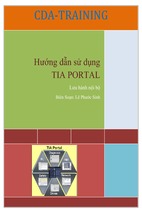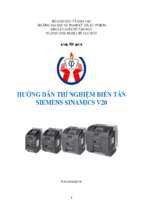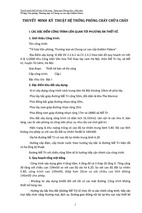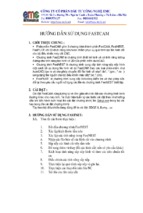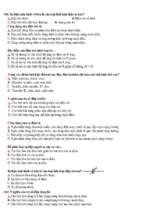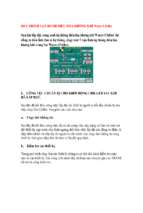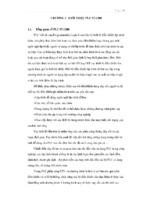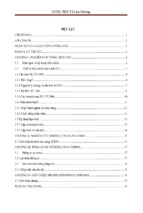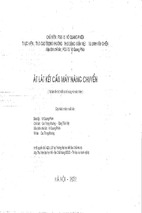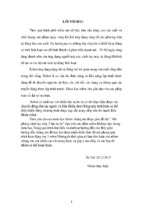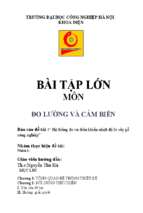Unsupervised Deep Learning in Python
Master Data Science and Machine Learning with Modern Neural Networks
written in Python and Theano
By: The LazyProgrammer (http://lazyprogrammer.me)
Introduction
Chapter 1: Principal Components Analysis
Chapter 2: t-SNE
Chapter 3: Autoencoders and Stacked Denoising Autoencoders
Chapter 4: Restricted Boltzmann Machines and Deep Belief Networks
Chapter 5: Feature Visualization
Chapter 6: Tricking a Neural Network
Conclusion
Introduction
When we talk about modern deep learning, we are often not talking about vanilla neural networks - but
newer developments, like using Autoencoders and Restricted Boltzmann Machines to do unsupervised
pre-training.
Deep neural networks suffer from the vanishing gradient problem, and for many years researchers
couldn’t get around it - that is, until new unsupervised deep learning methods were invented.
That is what this book aims to teach you.
Aside from that, we are also going to look at Principal Components Analysis (PCA) and t-Distributed
Stochastic Neighbor Embedding (t-SNE), which are not only related to deep learning mathematically, but
often are part of a deep learning or machine learning pipeline.
Mostly I am just ultra frustrated with the way PCA is usually taught! So I’m using this platform to teach
you Principal Components Analysis in a clear, logical, and intuitive way without you having to imagine
rotating globes and spinning vectors and all that nonsense.
One major component of unsupervised learning is visualization. We are going to do a lot of that in this
book. PCA and t-SNE both help you visualize data from high dimensional spaces on a flat plane.
Autoencoders and Restricted Boltzmann Machines help you visualize what each hidden node in a neural
network has learned. One interesting feature researchers have discovered is that neural networks learn
hierarchically. Take images of faces for example. The first layer of a neural network will learn some
basic strokes. The next layer will combine the strokes into combinations of strokes. The next layer might
form the pieces of a face, like the eyes, nose, ears, and mouth. It truly is amazing!
Perhaps this might provide insight into how our own brains take simple electrical signals and combine
them to perform complex reactions.
We will also see in this book how you can “trick” a neural network after training it! You may think it has
learned to recognize all the images in your dataset, but add some intelligently designed noise, and the
neural network will think it’s seeing something else, even when the picture looks exactly the same to you!
So if the machines ever end up taking over the world, you’ll at least have some tools to combat them.
Finally, in this book I will show you exactly how to train a deep neural network so that you avoid the
vanishing gradient problem - a method called “greedy layer-wise pretraining”.
“Hold up... what’s deep learning and all this other crazy stuff you’re talking about?”
If you are completely new to deep learning, you might want to check out my earlier books and courses on
the subject:
Deep Learning in Python
Deep Learning in Python Prerequisities
Much like how IBM’s Deep Blue beat world champion chess player Garry Kasparov in 1996, Google’s
AlphaGo recently made headlines when it beat world champion Lee Sedol in March 2016.
What was amazing about this win was that experts in the field didn’t think it would happen for another 10
years. The search space of Go is much larger than that of chess, meaning that existing techniques for
playing games with artificial intelligence were infeasible. Deep learning was the technique that enabled
AlphaGo to correctly predict the outcome of its moves and defeat the world champion.
Deep learning progress has accelerated in recent years due to more processing power (see: Tensor
Processing Unit or TPU), larger datasets, and new algorithms like the ones discussed in this book.
Formatting
I know that the e-book format can be quite limited on many platforms. If you find the formatting in this
book lacking, particularly for the code or diagrams, please shoot me an email at
[email protected] along with a proof-of-purchase, and I will send you the original ePub from
which this book was created.
Chapter 1: Principal Components Analysis
In this chapter we are going to talk about PCA or principal components analysis. There are 2 components
to their description:
1) describing what PCA does and how it is used
2) the math behind PCA.
So what does PCA do? Firstly, it is a linear transformation.
If you think about what happens when you multiply a vector by a scalar, you’ll see that it never changes
direction. It only becomes a vector of different length. Of course, you could multiply it by -1 and it would
face the opposite direction, but it can’t be rotated arbitrarily.
Ex. 2(1, 2) = (2, 4)
If you multiply a vector by a matrix - it CAN change direction and be rotated arbitrarily.
Ex. [[1, 1], [1, 0]] [1, 2]T = [3, 1]T
So what does PCA do? Simply put, a linear transformation on your data matrix:
Z = XQ
It takes an input data matrix X, which is NxD, multiplies it by a transformation matrix Q, which is DxD,
and outputs the transformed data Z which is also NxD.
If you want to transform an individual vector x to a corresponding individual vector z, that would be z =
Qx. It’s in a different order because when x is in a data matrix it’s a 1xD row vector, but when we talk
about individual vectors they are Dx1 column vectors. It’s just convention.
What makes PCA an interesting algorithm is how it chooses the Q matrix.
Notice that because this is unsupervised learning, we have an X but no Y, or no targets.
On Rotation
Another view of what happens when you multiply by a matrix is not that you are are rotating the vectors,
but you instead are rotating the coordinate system in which the vectors live.
Which view we take will depend on which problem we are trying to solve.
Dimensionality Reduction
One use of PCA is dimensionality reduction. When you’re looking at the MNIST dataset, which is 28x28
images, or vectors of size 784, that’s a lot of dimensions, and it’s definitely not something you can
visualize.
28x28 is a very tiny image, and most images these days are much larger than that - so we either need to
have the resources to handle data that can have millions of dimensions, or we could reduce the data
dimensionality using techniques like PCA.
We of course can’t just take arbitrary dimensions from X - we want to reduce the data size but at the same
time capture as much information as possible.
So if we want to go from 784 to 2 dimensions - so that we can visualize it - we want those 2 dimensions
to have as much information from X as possible.
Ex. info(1st col of Z) > info(2nd col of Z) > ...
How do we measure this information? In traditional PCA and many other traditional statistical methods
we use variance. If something varies more, it carries more information.
You can imagine the opposite situation, where a variable is completely deterministic, i.e. it has no
variance. Then measuring this variable would not give us any new information, because we already knew
what it was going to be.
So when we get our transformed data Z, what we want is for the first column to have the most information,
the second column to have the second most information, and so on.
Thus, when we take the 2 columns with the most information, that would mean taking the first 2 columns.
De-correlation
Another thing PCA does is de-correlation.
If we find correlations, that means some of the data is redundant, because we can predict one column from
another column.
So now if you take the coordinate system rotation view, you can imagine that if we rotated our coordinate
system to be aligned with the spread of these points, then the data would become uncorrelated.
Again the question is - how do we find Q so that we rotate the data in exactly this way?
Visualization
Once we have the information of our data sorted in descending order in each dimension, we can just take
the top 2 and make a scatter plot. This will then give us an idea of the separation of the data points, and it
allows us to create a visual representation of high-dimensional data.
Pre-processing and Overfitting
The last application of PCA we’ll talk about is pre-processing and overfitting.
You can imagine that our data is often noisy. Hopefully, the noise is small compared to the true pattern. In
that case, the variance of the noise, which should be small, would go into the last columns of our
transformed data Z, at which point we could just discard it.
We could then feed this new data into a supervised machine learning model such as logistic regression in fact we did this in my previous courses.
So by getting rid of the noise we are preventing overfitting by making sure we are not fitting to the noise.
To make this clear, here’s an imaginary data pipeline:
Input: X (data), Y (targets)
1) Convert X to Z --> Z = XQ
2) Take the first K columns of Z, call that ZK
3) Train your model on (ZK, Y), i.e. model.fit(ZK, Y)
4) Any further predictions can use the same model and pipeline:
1) zK = Qx
2) prediction = model.predict(zK)
You’ll see that this idea of unsupervised pre-training will come into play again when we study
autoencoders and RBMs.
Latent Variables
Another view of PCA is that the transformed variables Z are the “latent variables”, as in they are some
sort of underlying cause of the data X.
Then it makes sense that they should be uncorrelated, because they are just independent hidden causes.
It also makes sense that some of the data in X is correlated because they are just measurements you’re
taking of some data that is produced by a combination of those hidden causes.
What we are assuming when we do PCA is that the data is a linear combination of those hidden causes.
In fact with PCA the linearity goes both ways - the latent variable Z is a linear combination of the
observed variable X, but if you were to do a reverse transformation, the observed data X is also a linear
combination of the latent variable Z.
Z = XQ
X = ZQ-1
You’ll recall that we first encountered the idea of latent variables in my first unsupervised learning course
on clustering and Gaussian mixture models - because those models assumed that the identities of the
clusters were the latent variable.
The Math Behind PCA
Now let us turn to the second part of the PCA description - how to actually find the transformation matrix
Q.
To recap, I’ve just told you about all the magical things this Q matrix can do:
1) Make Z uncorrelated even though X is correlated
2) Order each column if Z by its information content (variance)
A lot of the steps here may seem arbitrary at first, but you’ll see how it all fits together in the end and
results in all the properties that I talked about in the previously.
The first step is to calculate the covariance of X.
C(x(i), x(j)) = E[ (x(i) - m(i))(x(j) - m(j)) ] = sum(n=1..N){ (xn(i) - m(i))(xn(j) - m(j)) } / N
Where m(i) is the mean of all x(i).
If i = j then it’s just the regular variance. In other words, the diagonals of the C matrix are the variances of
each dimension of X. This will be important later.
In matrix form:
C = (X - m)T (X - m) / N
This gives us a DxD matrix. Remember, D is the dimensionality and N is the number of data points.
Technically you can’t subtract the mean like that because it has a different shape than X, but we will
assume that broadcasting is being used.
Eigenvalues and Eigenvectors
Recall that a DxD matrix has D eigenvalues and D eigenvectors. If you don’t know what eigenvalues and
eigenvectors are, I’m going to give you a short introduction.
Remember that matrices in general change the direction of, or rotate, a vector. Eigenvectors of a matrix
are special vectors which are NOT rotated by the matrix, but just change in length. The change in length is
called the eigenvalue.
So we can relate the covariance matrix, its eigenvector, and its eigenvalue, using this equation, where e is
the eigenvalue and v is the eigenvector.
Cv = ev
There are some theorems which we won’t prove, but basically there will be D eigenvectors and D
corresponding eigenvalues, and the eigenvalues will be greater than or equal to 0.
Finding eigenvectors and eigenvalues is itself not a trivial task, and there are many algorithms that can do
this, including gradient descent. Since numpy already has a function to do this, we’re not going to worry
about it - just the theory is important to give you the right perspective.
Now we have these D eigenvalues, what do we do with them?
Again an arbitrary step, but let’s sort the eigenvalues in descending order. This means that the
corresponding eigenvectors have to be sorted in the same way.
e1 > e2 > e3 > ... > eD
Once we’ve done this, we can put them into matrices of size DxD. The eigenvalues will go in a diagonal
matrix of size DxD we’ll call E, and the eigenvectors will be lined up beside each other in a matrix we’ll
call V.
Ex. In 2 dimensions:
E = [ e1 0 ]
[ 0 e2 ]
V = [ v11 v12 ]
[ v21 v22 ]
Where v(i,j) is the ith component of the jth eigenvector.
It’s easy to prove that:
CV = VE
Try it yourself on paper with the scalar components.
One last ingredient is that the matrix V is orthonormal. This means that any eigenvector dotted with itself
is 1, and any eigenvector dotted with another different eigenvector is 0.
Ex.
viT vj = 0 if i != j
viT vi = 1
In matrix form:
VT V = I (the identity matrix)
Finally, we’ll now look at the transformed data, Z. Remember that we still don’t know what Q is. But let’s
solve for its covariance. Notice how we can express the covariance of Z in terms of the covariance of X.
CZ = (Z - mZ )T (Z - mZ ) / N
CZ = (XQ - mQ)T (XQ - mQ) / N
CZ = QT (X - m)T (X - m)Q / N
CZ = QT [(X - m)T (X - m) / N ] Q
CZ = QT C Q
We can express the covariance of Z in terms of the covariance of X and Q!
Next, look what happens if we choose Q = V.
CZ = VT CV
But remember that CV = VE.
CZ = VT VE
And remember that V is orthonormal so VT V = I (the identity matrix). Thus:
CZ = E
We get that the covariance of Z is just equal to E, which is the diagonal matrix of eigenvalues.
So what does this all mean?
Since all the off-diagonal elements of E are 0, that means any dimension i is not correlated with any other
dimension j, which means there are no correlations in the transformed data.
So by choosing Q = V, we’ve decorrelated Z.
Next, because we sorted E by the eigenvalues in descending order, that means the first dimension of Z has
the most variance, the second dimension of Z has the second most variance, and so on.
The PCA Objective
One thing that is not immediately obvious with the PCA derivation is that it actually minimizes an
objective function.
The objective function is what you would naturally expect - it’s the squared reconstruction error of the
data.
J = || X - XQQ-1 ||2
Since Q is orthonormal, we know that QT = Q-1.
In other words, the transpose of Q is equal to the inverse of Q.
We can thus reconstruct X using the transpose instead of the inverse.
We’ll encounter this again when we look at autoencoders.
Qk is just the first k eigenvectors of the covariance of X - meaning that it’s a Dxk matrix.
By multiplying X by Qk, we get Zk, the first k columns of Z. Remember, this gives us Z “without the
noise”.
Since we are now not using the full Q, there will be a non-zero reconstruction error.
And we can get back the reconstruction by multiplying by QkT .
Xhat = ZkQkT
J = || X - XQkQkT ||2
You’ll want to keep this idea of the PCA objective function in your memory because we are going to
encounter it again later.
Exercises
Try PCA on the MNIST dataset. (Use the sci-kit learn library or try writing PCA yourself)
Chapter 2: t-SNE
In this lecture we are going to talk about another dimensionality reduction and visualization method called
t-SNE. The t means we are going to incorporate the t-distribution and SNE stands for “stochastic neighbor
embedding”.
One big advantage of t-SNE is that it’s a nonlinear method, so it is more expressive than PCA.
Why study t-SNE?
2 reasons:
1) t-SNE was jointly developed by Geoffrey Hinton, who as you know, is one of the main figures of deep
learning.
2) by doing t-SNE, we are seeing how the limitations of PCA can be overcome by using a more complex
mathematical model.
One key difference between PCA and t-SNE, other than the fact that t-SNE is non-linear, is that there is no
transformation model with t-SNE.
Instead, t-SNE just modifies the outputs directly in order to minimize the cost function.
What this means is that, you won’t have any train and test sets, and you can’t transform data after fitting on
some other data.
The way that t-SNE works is essentially it tries to preserve the distances between each input vector.
We will start with symmetric SNE since it intuitively makes more sense.
On the original data X, we define a joint probability distribution p(i,j) which is equal to:
p(i,j) = exp(-||xi - xj||2 /(2s2)) / sum[k!=m]{ exp(-||xm - xk||2 /(2s2)) }
Note that i and j here are not the index for the dimensions like we did with PCA, but rather the ith and jth
data point in the dataset, i.e. i and j are the ith and jth sample.
Notice it kind of looks like a Gaussian distribution. You can think of “s” as a hyperparameter. It’s
controlling the “spread” of the distribution.
Next, we have our low-dimensional mapping Y, which we define in the same way, but there is no s term.
q(i,j) = exp(-||yi - yj||2) / sum[k!=m]{ exp(-||ym - yk||2) }
Note that we just set p(i,i) = q(i,i) = 0.
So we’ve defined 2 probability distributions, one between every pair of points in X, and one between
every pair of points in Y.
We usually just initialize every data point in Y randomly.
i.e. If we’re looking for a 2-D representation, we’ll create Y as:
Y = np.random.randn(N, 2)
Once we’ve done that, we can try to find a better Y by optimizing some objective function that relates
p(i,j) and q(i,j).
If you are not familiar with how we compare 2 probability distributions, we usually use the KullbackLeibler divergence or KL divergence for short.
C = DKL(P || Q) = sum[i,j]{ p(i,j)log( p(i,j) / q(i,j) ) }
If P and Q are exactly the same, this would be 0.
How we solve this problem is the same as how we solve all other problems of this type - we take the
derivative of the objective and do gradient descent.
Notice how with this type of model we don’t have weights - we just have Y. So are taking the gradient
with respect to Y, which is the output mapping itself.
i.e.
Y <- Y - learning_rate*dC/dY
One problem with symmetric SNE and the SNE that came before it is known as the “crowding problem”,
which prevents gaps from forming around the natural clusters.
What t-SNE does is it uses slightly different distributions for Q and P, which helps space out the clusters
better.
The new P and Q are defined as follows:
p(i,j) = [ p(i | j) + p(j | i) ] / 2N
Where:
p(j | i) = exp(-||xi - xj||2 /(2si2)) / sum[k!=i]{ exp(-||xi - xk||2 /(2si2)) }
Notice how here each sample has its own “s”.
q(i,j) = (1 + ||yi - yj||2)-1 / sum[k!=m]{ (1 + ||yk - ym||2)-1 }
The Q distribution uses the t-distribution, hence the name.
The cost function remains the same as before.
Note that we won’t actually implement t-SNE - even though it should be relatively simple given the
definitions above.
It’s easy to define the cost and find its derivative, which is more than we can say for many of the deep
learning models we’ve worked with.
The problem is that it’s slow and has huge RAM requirements - in fact t-SNE will probably crash on your
computer with the full MNIST dataset.
Why? Because we need to calculate q(i,j) and p(i,j) for i=1..N and j=1..N, this is naturally an O(N2)
algorithm.
There is a variant of it, which is called Barnes-Hut, that is O(NlogN) run time, but still has huge RAM
requirements. This is the default method used in Sci-Kit Learn.
One solution is to take a sample of just a few hundred data points and do t-SNE on that, but of course you
can increase this amount if you’re willing to wait longer and you have enough RAM.
Exercises
Try t-SNE (from the sci-kit learn library) on the MNIST dataset.
Try writing your own naive implementation given the definitions above, and take advantage of Theano’s
automatic differentiation.
Chapter 3: Autoencoders and Stacked Denoising Autoencoders
In this chapter we are going to talk about autoencoders. Autoencoders are actually nothing really new, just
a small twist on something you already know.
I always say that a supervised machine learning model has 2 main functions as its API, train or fit, and
predict.
Usually when we call a neural network, we call model.fit(X, Y), and then to make predictions we call
model.predict(X).
But what if we just make a neural network try to predict itself? So we call model.fit(X, X) instead.
o---o---o
x z x’
That’s exactly what an autoencoder is.
In most of my previous courses, we did classification, but remember that our X can be any real value.
So if you are trying to predict real values in general, you can use the squared error, and it becomes more
like a regression.
You can alternatively still use the cross-entropy error, and consider your inputs and outputs to be binary
variables, even for variables that are not exactly binary.
You’ll see that we do this with both autoencoders and RBMs, and you’ll see that both error functions can
work.
You can think of images like MNIST as having pixel intensities. 0 would be no intensity at all, and 1
would be maximum intensity, since we always scale by 255.
To make the outputs go between 0 and 1, we are going to use the sigmoid function at both the hidden layer
and output layer.
One slight modification we sometimes use for both autoencoders and RBMs is the idea of shared weights.
So instead of using another weight at the output layer, we just use the transpose of the first weight.
Ex.
Z = sigmoid(XW + b)
Xhat = sigmoid(ZWT + c)
We first encountered the idea of shared weights when we looked at convolutional neural networks, since


